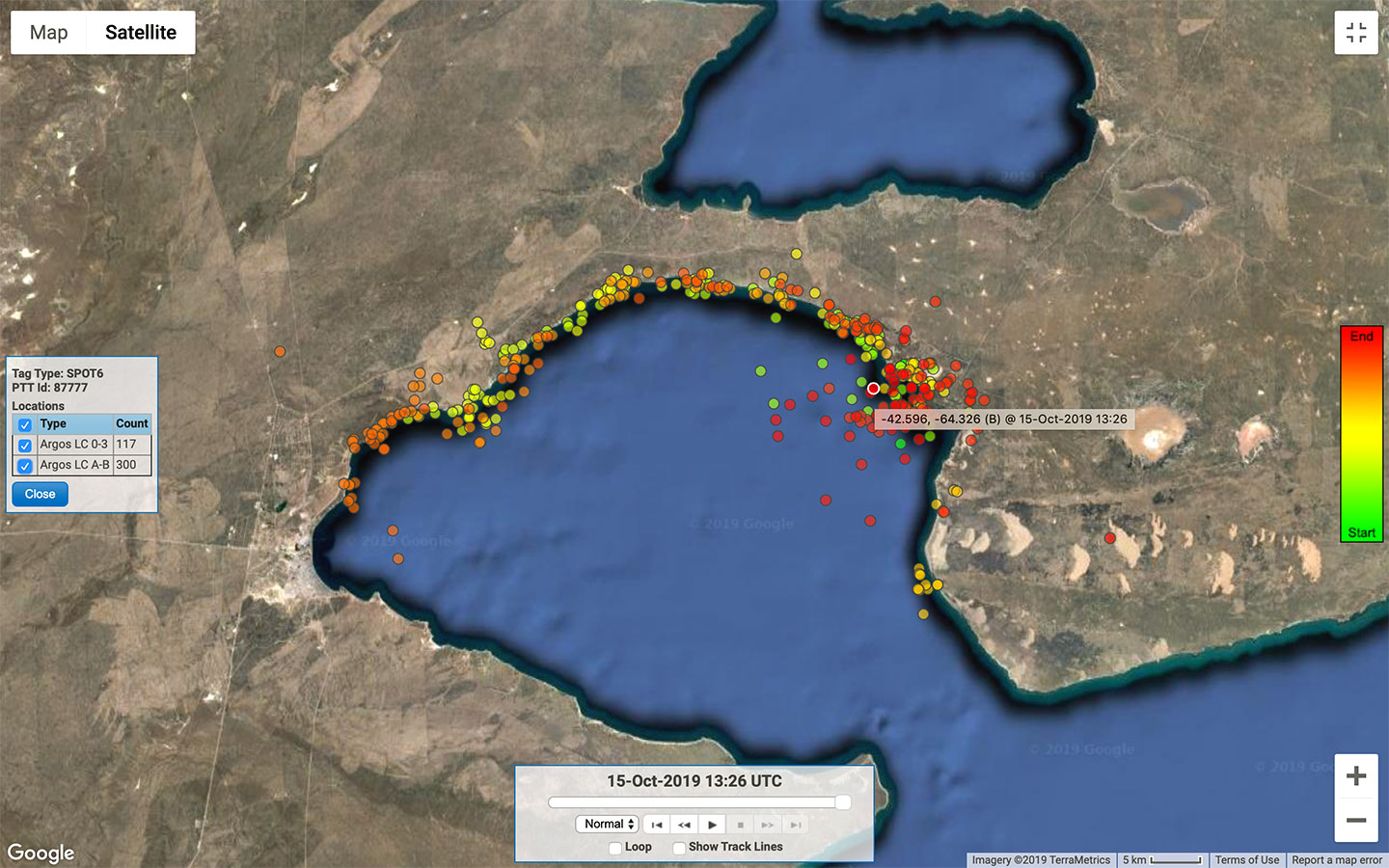Photo: F. Sucunza
Cebollita’s 184 day tracking route (17,694 km)
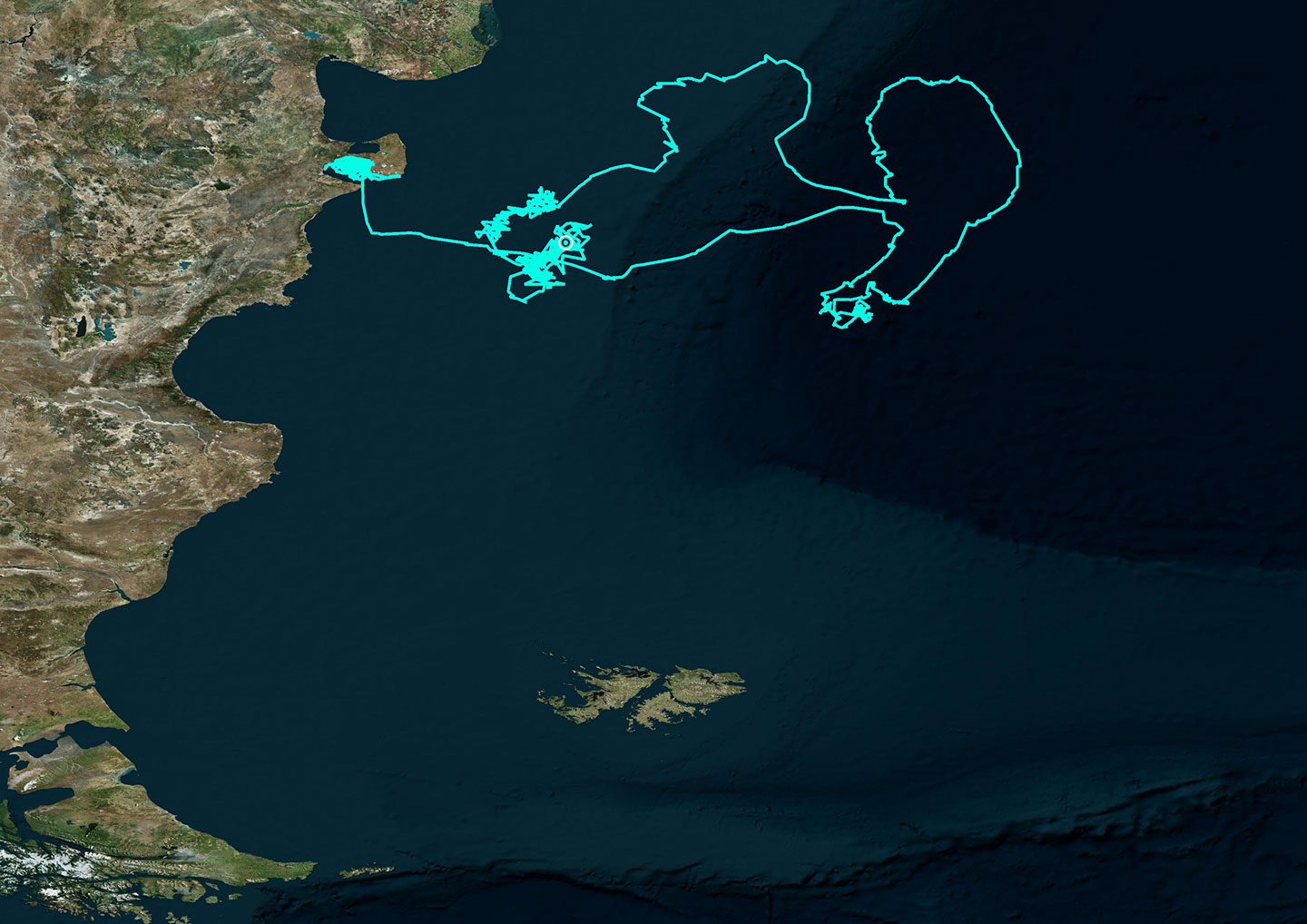
March 24 – March 29, 2020
On March 29, after 184 days, we lost connection with Cebollita’s satellite tag. This mother and her calf were feeding in the rich waters over the continental shelf. Shortly after leaving Golfo Nuevo, at the end of November 2019, Cebollita crossed the continental slope without stopping, and then explored the deep waters of the South Atlantic Ocean Basin. At the beginning of January, she returned to the middle of the continental shelf where she remained, close to the continental slope, between latitude 40° and 45° S.
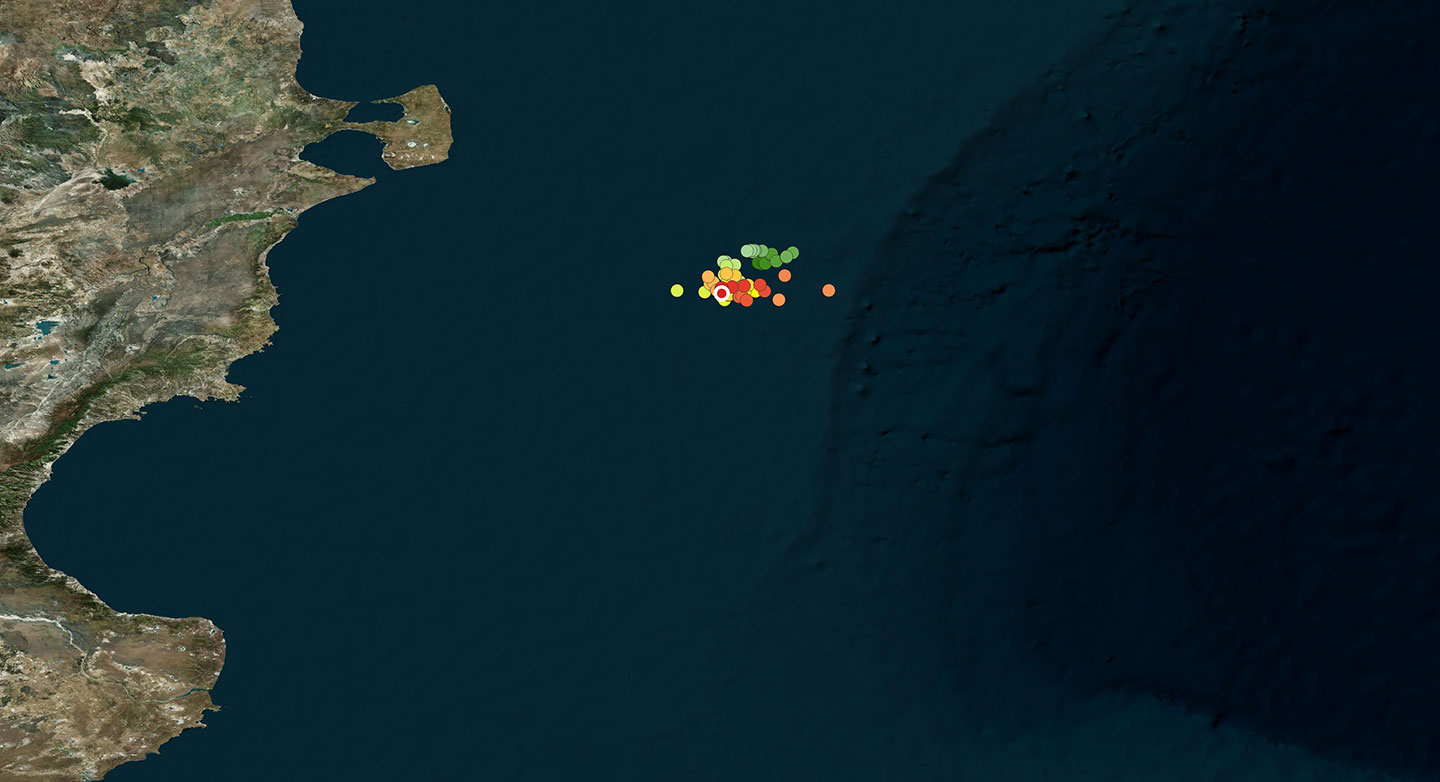
March 17 – March 23, 2020
Cebollita and her calf have been feeding over the continental shelf off the coast of Chubut province for two months. They are now close to the continental slope, about 300 kilometers from Golfo Nuevo, which they left 114 days ago (November 30, 2019).
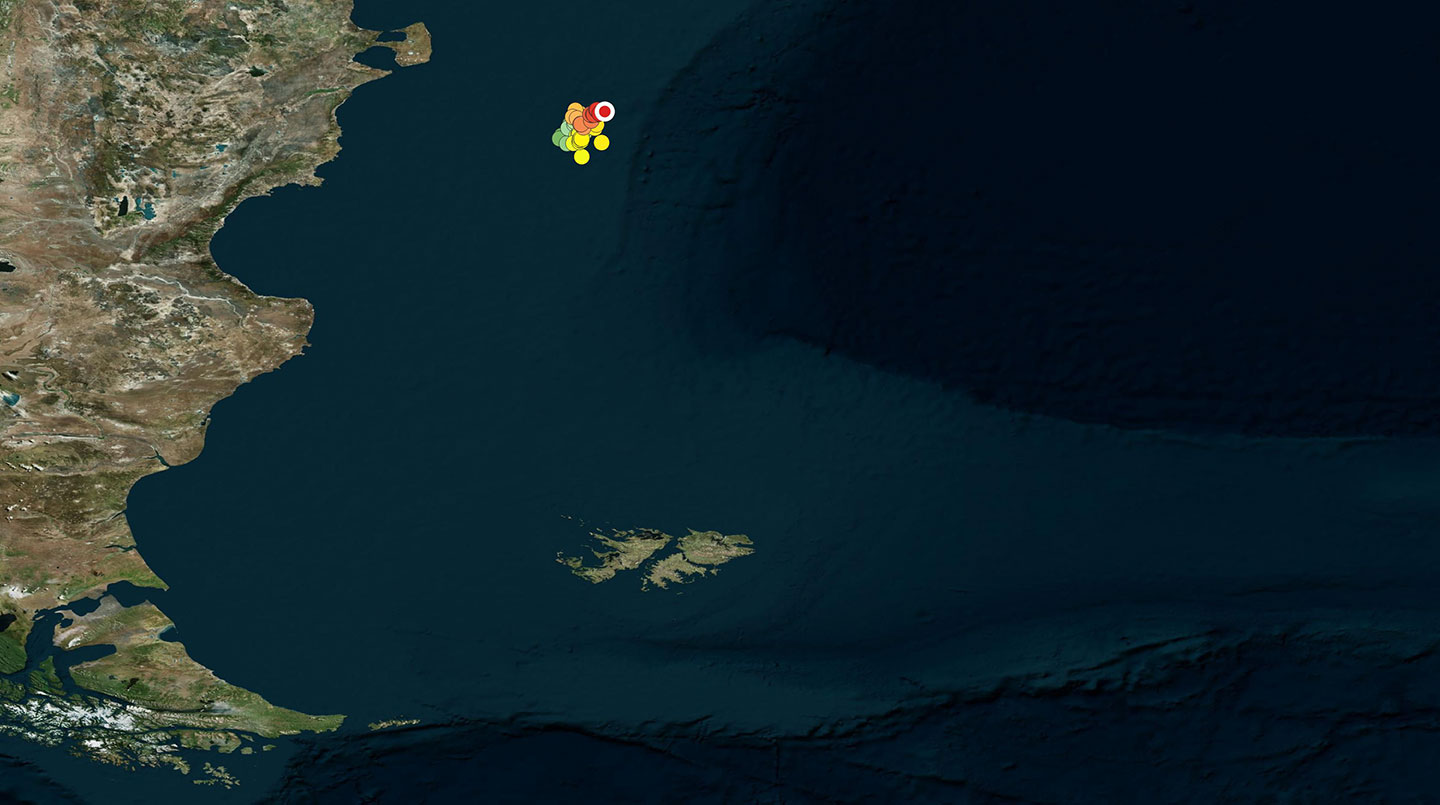
March 11 – March 16, 2020
Cebollita and her calf continue feeding in the same middle section of the continental shelf, at the latitude of Punta Tombo (which is being deserted by its penguins this month. The adults have finished their work of raising their chicks, and are moulting their feathers to withstand the coming winter at sea).
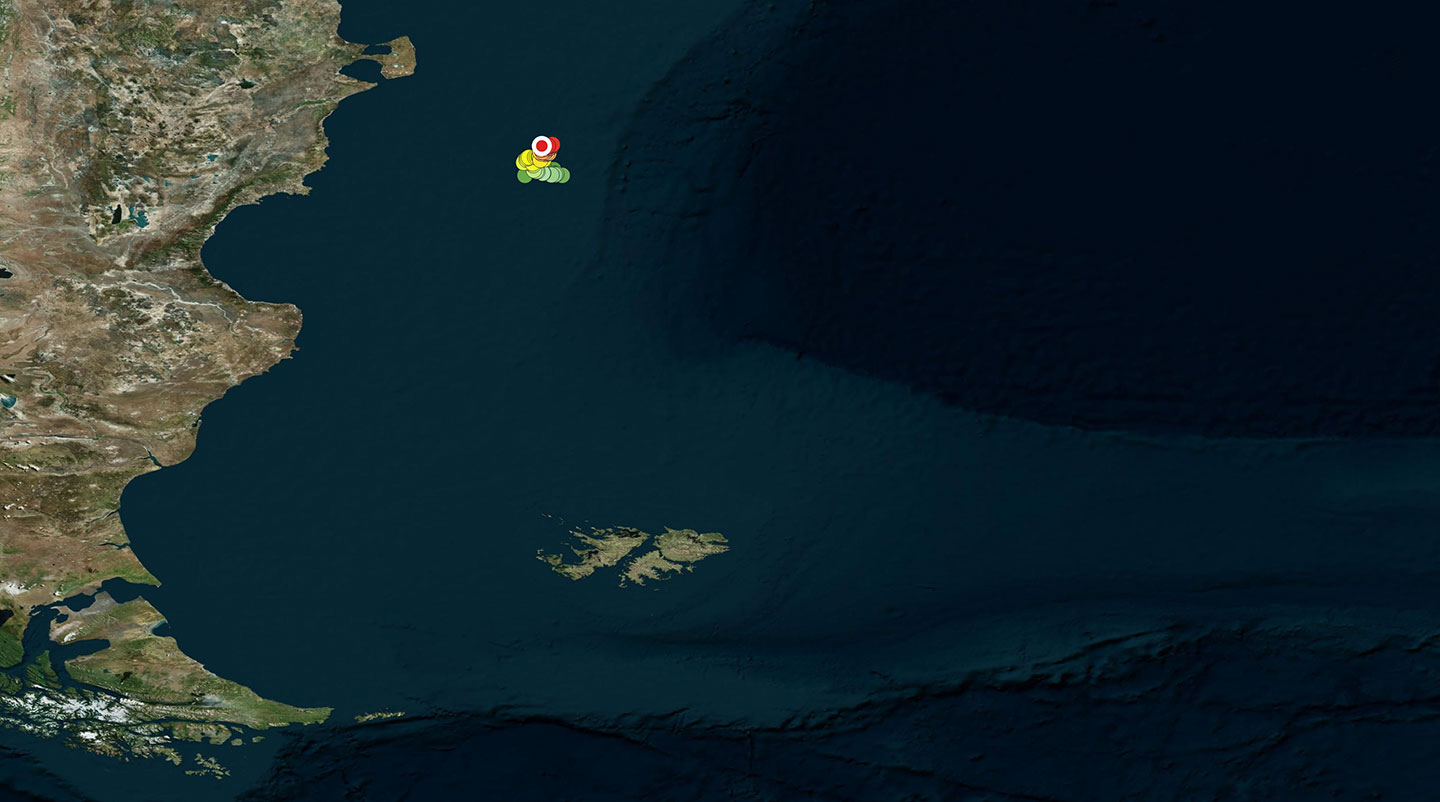
March 04 – March 10, 2020
Mother and calf continue feeding over the continental shelf close to the continental slope at the latitude of Cabo Raso on the coast of Chubut province. Over the last 45 days, these whales have explored an area of more than 26,000 square kilometers.
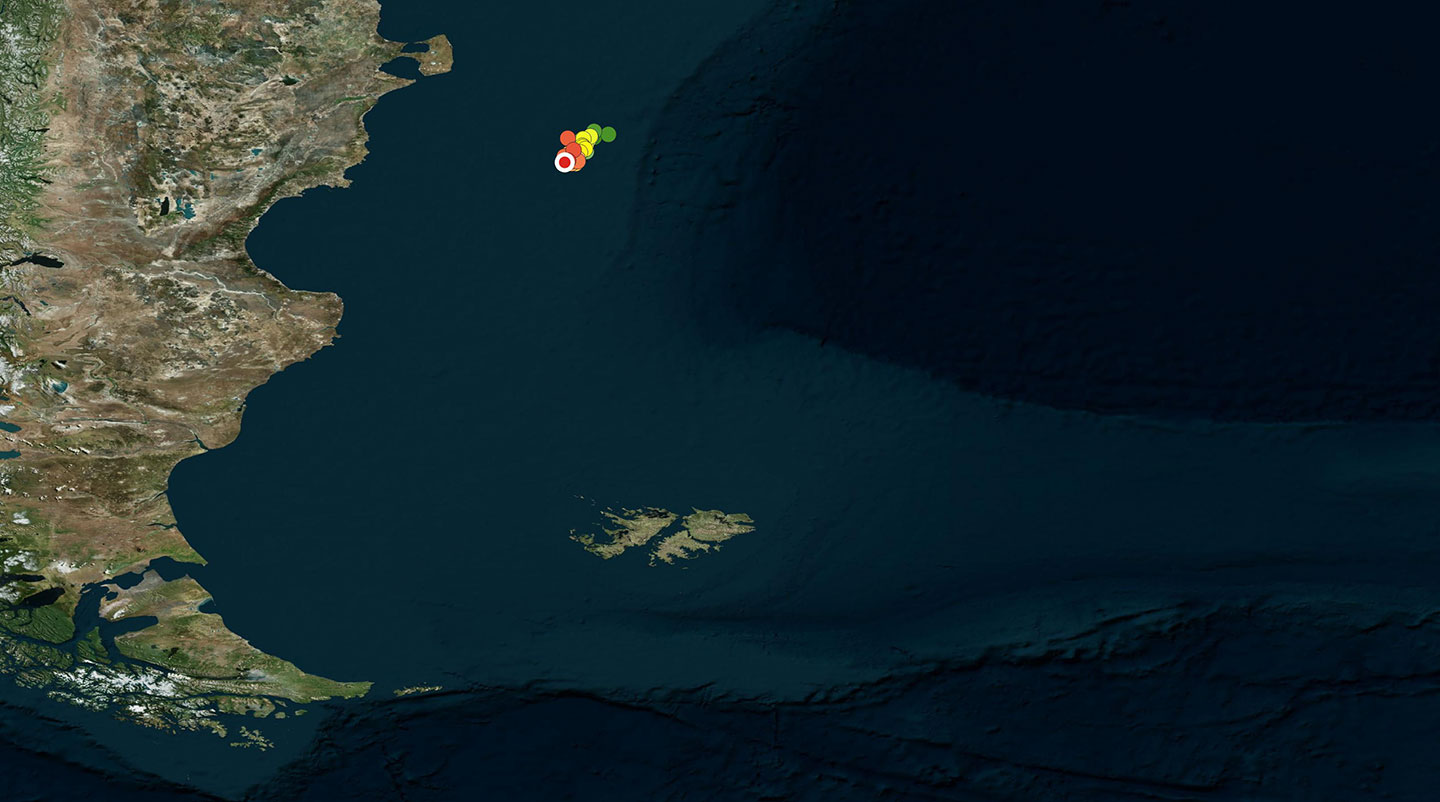
February 25 – March 03, 2020
Cebollita and her calf traveled in an “8” shaped route, SW-NE. They are now close to the continental slope about 300 kilometers from the entrance to Golfo Nuevo.
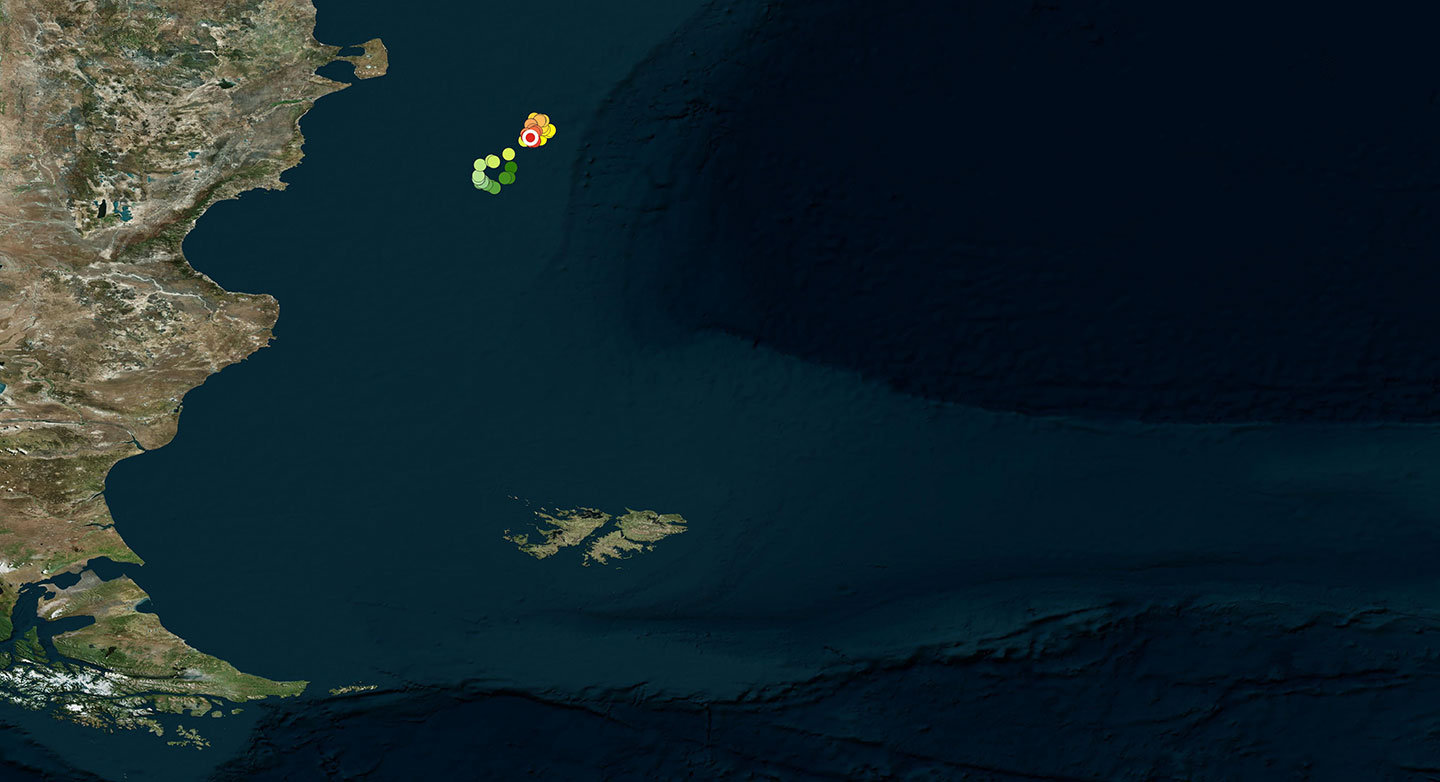
February 19 – February 24, 2020
For the past month mother and calf have been in a small section over the continental shelf, moving slightly southeastwards closer to the continental slope, off the coast of Chubut province.

February 11 – February 18, 2020
This mother has been transmitting data for 156 days. She and her calf remain in a small area of the continental shelf, 300 kilometers east of Chubut Province, at the latitude of Isla Escondida.

February 07 – February 10, 2020
Cebollita continues in the middle of the continental shelf at latitude 44° S, off the center of Chubut Province. Over the last three weeks this mother and calf have covered 5,000 square kilometers.

January 29 – February 06, 2020
Mother and calf have stayed in a 9,000 kilometer square, highly productive area off the shores of Chubut province. Cebollita and Paciencia are the only tagged whales that remain at the latitude of Peninsula Valdés.

January 21 – January 28, 2020
Cebollita and her calf spent last week feeding over the continental shelf off the coast of Chubut province.

January 12 – January 20, 2020
Cebollita and her calf are still the only mother-calf pair over the continental shelf. After traveling a short distance, they have found a rich feeding area 230 kilometers off the entrance to Golfo Nuevo, where they have been feeding these past days.

January 06 – January 11, 2020
This week Cebollita and her calf traveled west, across the continental slope to the waters above the continental shelf. They are now in the region where Misterio is, off the Golfo San Matias. Cebollita is the only mother who is in the relatively shallow waters over the continental shelf, an area preferred by the solitary whales.

December 29, 2019 – January 05, 2020
Cebollita and her calf continue traveling. During this week they made a large counterclockwise circle, ending up about 150 kilometers from where they began their circular route.

December 22 – December 28, 2019
Cebollita lost interest in the area in which she had been feeding and swam off towards the northeast. She and her calf are now in very deep waters, about 65 kilometers from Afuerita and her calf.

December 16 – December 21, 2019
Like other mothers with calves, Cebollita found an small area rich in food with which to satisfy her hunger, after various months of fast. Cebollita and her calf have been in an area of less than 1000 square kilometers for the past week.

December 05 – December 15, 2019
Cebollita and her calf arrived at the spot in the oceanic basin where the other females with calves are. Could this be a feeding zone that is exclusively for mothers with calves? Will they all remain in this very deep area off the continental shelf in the following months? Will they continue their travels farther southward towards higher latitudes? Year after year this project #Trackingwhales will try to find answers to questions like these providing data crucial to the conservation of this species.

November 26 – December 04, 2019
Cebollita and her calf swam along the southern external coast of the Valdés Peninsula for a few days, reaching Punta Delgada. They then returned to the mouth of the gulf, crossing to Punta Ninfas, and on November 30th they began their migration. They initially traveled southwards, but at the latitude of the mouth of the Chubut River they turned east and are now traveling towards the continental slope.

November 17 – November 25, 2019
Cebollita and her calf are still in the area of Puerto Pirámides, close to the tourist boats and being watched by the hundreds of visitors who come to this location. Cebollita and Tigresa are the last whales with transmitters which remain inside Golfo Nuevo.

November 10 – November 16, 2019
Cebollita and her calf returned to Puerto Pirámides, where various whale watching guides have registered her presence with photographs, and have also reported her presence to the scientists working on this project. The tracking team has been close to this mother and her calf, whose sex, a female, was determined during these interactions.
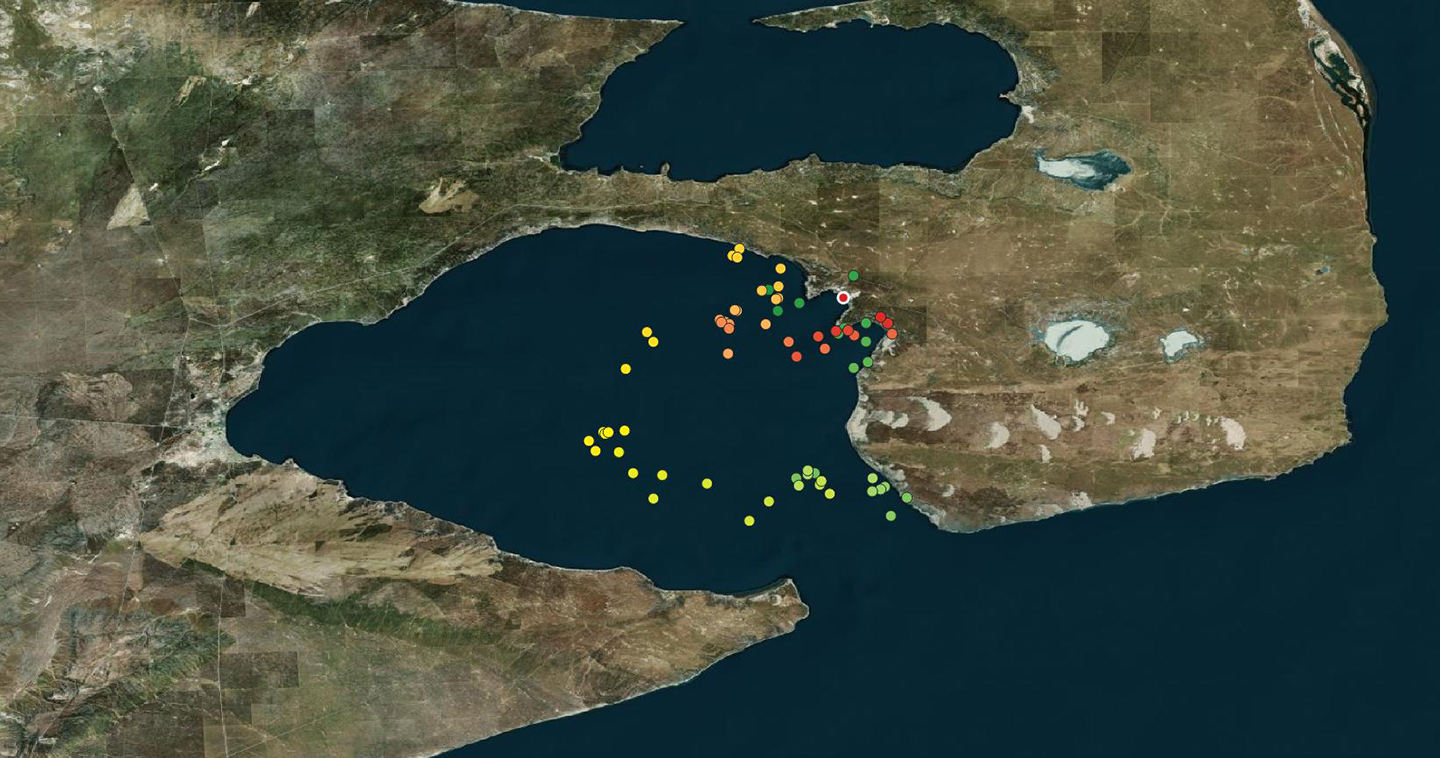
November 2 – November 9, 2019
Cebollita and her calf have traveled some 200 kilometers inside the gulf, heading towards the center of the gulf at times then later returning to the vicinity of Morro Nuevo, where she was seen by a tracking team two days ago. From there she returned to the bay of Puerto Piramides.

October 27 – November 1, 2019
After remaining for some days in the deepest waters of the gulf this female and her calf returned to the bay of Puerto Pirámides. She was observed in this area by the tracking team and was also reported various times as having been seen by whale watching tourist boats. Right whales are curious animals and readily approach boats. The mothers control their enormous bodies with great care so as to avoid touching the boats.
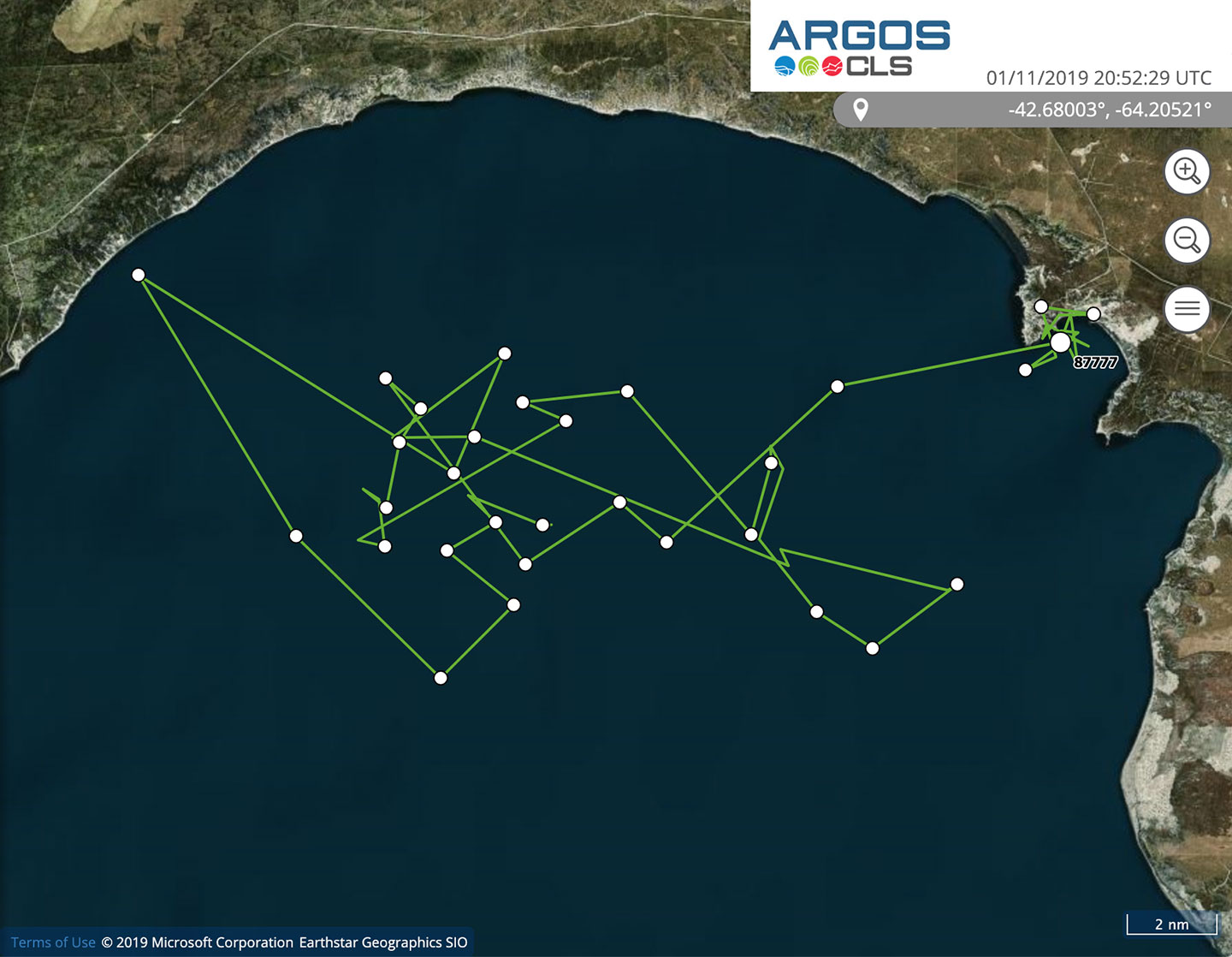
October 16 – October 26, 2019
This female and her calf remain inside Golfo Nuevo, between Puerto Pirámides and the Ameghino Isthmus. In this whale population, during these months, the gulf is where the majority of mothers with calves is found. However, in the decade of the 1970’s, the mother whales were mostly to be found along the external coast of the Valdes Peninsula, between Punta Norte and Caleta Valdes.
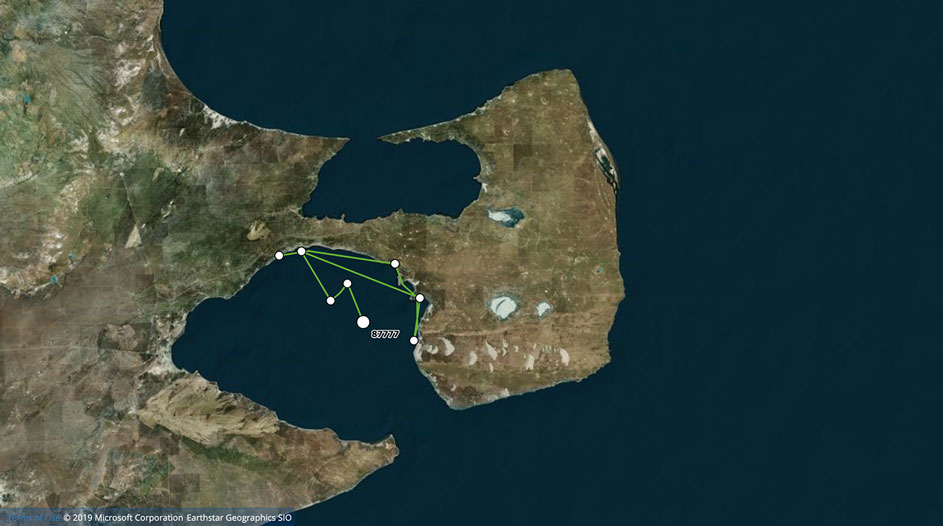
September 26 –October 15, 2019
This adult female and her calf remained in the zone of Puerto Pirámides, including inside the small bay in front of the town. Cebollita also traveled to the area around Puerto Madryn and made a brief sortie to the center of Golfo Nuevo on her return trip to Puerto Pirámides. At times adult whales can be seen in the deep waters in the gulfs making prolonged immersions, possibly to obtain some food.
